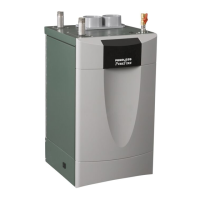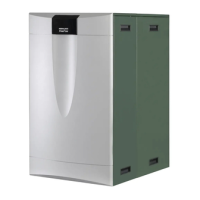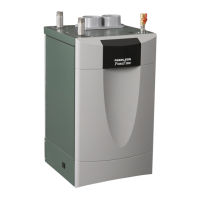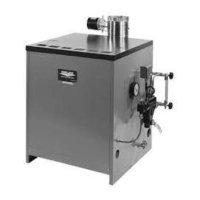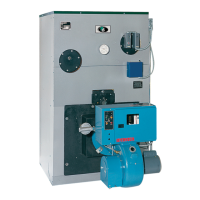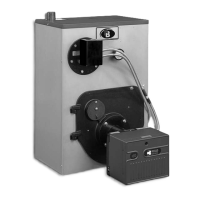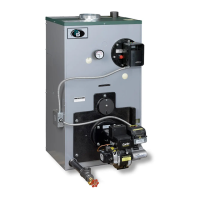How to fix supply sensor not connected error on PEERLESS Boiler?
- KkimpatrickSep 5, 2025
If your PEERLESS Boiler displays the error 'SUPPLY SENSOR NOT CONNECTED', check the harness and sensor.
How to fix supply sensor not connected error on PEERLESS Boiler?
If your PEERLESS Boiler displays the error 'SUPPLY SENSOR NOT CONNECTED', check the harness and sensor.
How to troubleshoot ignition error on PEERLESS PureFire PF-140?
If you are experiencing an ignition error with your PEERLESS Boiler, follow these steps: 1. Watch the igniter through the observation window. 2. If no spark is present, check the spark electrode for the proper 3/16" gap. 3. Remove any corrosion from the spark electrode with abrasive. 4. If spark is present but no flame, check the gas supply to the boiler. Check for high or low pressure. 5. If there is a flame, check the flame signal ignition log in the Installer Menu. If values for flame signal are less than 3.1 µA, check wiring connections and clean the harness connector at the control. 6. Determine if gas valve is opening by monitoring gas pressure. 7. Check gas pressure.
What to do for false flame detected after shutdown on PEERLESS Boiler?
If your PEERLESS Boiler displays 'A19 - FALSE FLAME DETECTED AFTER SHUTDOWN', check the flame sensor and igniter to ensure there is no short to ground. This error may also indicate that the gas valve isn’t closing completely.
Why is the return higher than supply on my PEERLESS Boiler?
If you see 'RETURN HIGHER THAN SUPPLY' on your PEERLESS Boiler, check the system piping to ensure water enters the return connection and exits the supply connection correctly. Also, compare the supply thermistor reading to the temperature gauge; if they don’t match, replace the supply thermistor.
How to fix poor ground error on PEERLESS Boiler?
If your PEERLESS Boiler is showing 'POOR GROUND' error, check the boiler ground and harness.
What causes high stack temperature in PEERLESS Boiler?
If your PEERLESS Boiler has a 'HIGH STACK TEMPERATURE', and the flue pipe is hot, check the flue temperature and compare it to the values in Table 8.5. Also, inspect for proper gas input and combustion readings, and check for a dirty heat exchanger. If the flue pipe is not hot, check the flue sensor and harness.
How to troubleshoot a blocked vent in PEERLESS PureFire PF-140 Boiler?
If you have a blocked vent in your PEERLESS Boiler, check for a blocked vent pipe or blocked heat exchanger. Also, check the switch and tubing connected to the switch.
What to do if PEERLESS PureFire PF-140 Boiler showing false flame detected?
If your PEERLESS Boiler shows a 'FALSE FLAME DETECTED' error, first verify there is no flame in the observation port, then check the sensor.
How to fix hot/neutral reversed error on PEERLESS Boiler?
If your PEERLESS Boiler displays the error 'HOT/NEUTRAL REVERSED', verify the polarity of the incoming wiring and check the boiler ground and harness.
What to do if there is a false flame detected before ignition in my PEERLESS Boiler?
If you're experiencing a false flame detected before ignition with your PEERLESS Boiler, check the flame sensor and igniter to ensure there are no shorts to ground.
| Fuel Type | Natural Gas or Propane |
|---|---|
| AFUE | 95% |
| Efficiency | 95% |
| Ignition | Direct Spark Ignition |
| Input BTU | 140, 000 BTU/h |
| Warranty | heat exchanger |
| Heating Capacity | 133, 000 BTU/hr |
Follows installation instructions in order for logical sequence and safety.
Explains definitions of DANGER, WARNING, CAUTION, NOTICE boxes for hazards.
General info on boiler handling, inspection, and contractor qualifications.
Installation must comply with state/local codes and national standards.
Details Massachusetts requirements for CO detectors, signage, and exemptions.
Specifies minimum clearances around the boiler for access and installation.
Details requirements for combustion and ventilation air supply based on National Fuel Gas Code.
Guidelines for preparing sketches and notes for boiler installation layout.
General guidelines for boiler installation, including drain pan and level installation.
Instructions for mounting the boiler using the optional wall bracket.
Instructions for installing the boiler in a floor-standing configuration.
General installation requirements for venting and air intake systems.
Lists approved materials for exhaust vent and air intake piping.
Guidelines for locating vent and air intake pipes and termination.
Provides sizing information for exhaust vent and air intake pipes.
Instructions for drilling a hole for combustion gas sample testing.
Steps for safely removing an existing boiler from a common venting system.
Details exhaust connection, pipe support, and joint sealing requirements.
General guidelines for water supply and return piping, system cleaning, and protecting components.
Discusses boiler operation in closed-loop systems and minimum flow rates.
Describes key system components like pressure gauges, air eliminators, and expansion tanks.
Discusses the importance of the pressure relief valve installation and discharge piping.
Provides guidance on using glycol solutions for freeze protection.
General requirements for fuel piping installation according to codes and gas supply.
Information on determining required gas flow rate and pipe capacity.
Instructions for installing gas supply piping, including sediment traps and warnings.
Explains the operation and settings of the main gas valve and recommended CO2 settings.
General requirements for condensate disposal and system operation.
Explains the condensate system components and their function.
Specifies approved materials for condensate drain piping.
Provides guidance on sizing condensate drain piping.
Instructions for installing condensate drain piping and recommendations for condensate pumps.
General wiring requirements according to local codes and the National Electrical Code.
Details customer connections for various boiler models and their terminals.
Illustrates typical zone circulator relay wiring.
Lists internal wiring components and their functions.
Overview of the boiler control, its safety functions, and available heating/DHW modes.
Explains the boiler's ignition sequence graphically and step-by-step.
Discusses boiler control settings like installation location, vent material, and freeze protection.
Details the different Central Heating (CH) modes available for operation.
Overview of DHW modes and priority settings.
Information on setting up service reminders through the control.
Explains how to use the System Test mode for setup and troubleshooting.
How to view boiler status, fault history, and error codes.
Provides information on sensor resistance values at different temperatures.
Overview of cascading boilers for increased capacity and system wiring.
How to restore factory or site default settings.
Initial checks before starting up the boiler.
Steps for filling the boiler and system with water and checking for leaks.
Procedures for checking gas supply pressure and connections.
Steps for verifying boiler operation and shutdown at setpoint.
Safety instructions and step-by-step guide for lighting and operating the boiler.
Explains blocking errors, their display, and corrective actions.
Explains locking errors, their display, and how to reset them.
Information on error messages specific to cascade systems.
Explains warning errors related to sensors and cascade system faults.
Safety information regarding refractory ceramic fiber products and precautions.
General observations and checks for a boiler in use, including safety and leak checks.
Weekly maintenance task: flushing the low-water cut-off.
Annual inspection checklist for qualified service technicians.
Instructions for removing and cleaning condensate tanks and hoses.
Procedure for cleaning the heat exchanger coils and combustion chamber.
Table showing dimensional data for PF-50, PF-80, PF-110 & PF-140 boilers.
Table of boiler input, output, heating capacity, and efficiency ratings.
Dimensional drawings for specific boiler models.
Table detailing fan speeds for different boiler models and modes.
Dimensional drawings for PF-210 and PF-399 boiler models.
Specifications for the boiler's main control unit, including voltage and sensor data.
Table detailing electrical ratings for blowers, gas valves, and pumps across boiler models.
Illustrated list of general repair parts for specific boiler models.
Detailed list of general repair parts with quantities and stock codes.
Illustrated list of heat exchanger/burner assembly parts.
Detailed list of heat exchanger/burner assembly parts with stock codes.
Illustrated list of general repair parts for PF-210 and PF-399 models.
Detailed list of general repair parts for PF-210 and PF-399 models.
Illustrated list of heat exchanger/burner assembly parts for PF-210 and PF-399.
Detailed list of heat exchanger/burner assembly parts for PF-210 and PF-399.
Overview of boiler status displays, including initialization and standby modes.
Displays for Central Heating (CH) trial for ignition and demand states.
Displays for Domestic Hot Water (DHW) trial for ignition and demand states.
Displays indicating when the boiler supply temperature reaches the setpoint.
Displays for Freeze Protection and Store Warm Hold functions.
Displays related to ignition and flame failure events.
Displays for blocking errors and lockout errors, indicating abnormal conditions.
Information on programmed service intervals and alerts.
Status displays for master and dependent boilers in a cascade system.
Overview of accessing and navigating the user menu for settings and status.
User menu screens showing current supply, system, and DHW temperatures.
User menu screens for Central Heating, DHW, Time/Date, and Temperature Units settings.
User menu screen for displaying last block and lockout messages.
Instructions for accessing and navigating the installer menu.
Installer menu screens for viewing supply setpoint, fan speeds, flame signal, and ignition attempts.
Installer menu for pump mode, location, vent material, freeze protection, and safety functions.
Installer menu for CH modes, pump post purge, and ramp delay modulation.
Installer menu for outdoor reset, system presets, boost function, and anti-cycling.
Installer menu for DHW modes, priority, heat dump, and maximum allowable rate.
Installer options for setting service notification parameters (time, cycles, date).
Installer options for forcing boiler operation at low, ignition, or maximum power.
Installer options for cascade settings like address selection, delays, and differentials.
Installer options for cascade calculated setpoints, start/stop rates, and rotation interval.
Options to restore factory or save/reset site defaults.
A template for recording combustion test data and jobsite information.
